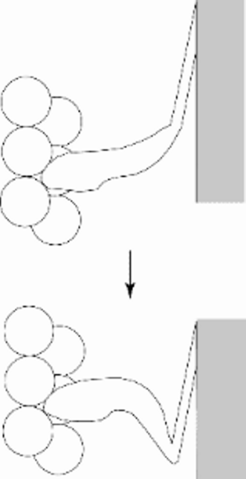Introduction to Muscle Contraction, Part 1
The Cross-Bridge Cycle
In the absence of ATP, the myosin cross-bridge binds tightly to actin filaments. However, it also binds and hydrolyses ATP. ATP binding brings about a rapid dissociation of the cross bridge from actin. Thus the cross bridge can bind either actin or ATP but to both only transiently. The presence of the ATP γ-phosphate is crucial for dissociation since ADP alone has little effect. Solution kinetic observations were very important in establishing the relationship between the hydrolysis of ATP and the generation of force. A key feature of this process is the observation that transduction of the chemical energy released by the hydrolysis of ATP into directed mechanical force should occur during product release (ADP and inorganic phosphate, Π) rather than during the hydrolysis step itself (Lymn and Taylor 1971). Without actin, myosin is product-inhibited and is a poor ATPase.
Mg-ATP rapidly dissociates the actomyosin complex on binding to the ATPase site of myosin; myosin then hydrolyzes ATP and forms a stable myosin-products complex; actin recombines with this complex and dissociates the products, initially the γ-phosphate ion thereby forming the original actin-myosin complex. Force is generated during the last step.

Kenneth C. Holmes
Figure 3: Numerous experiments (mostly negative) indicated that the scheme shown in Fig 1 needed revision: only the distal part of the cross bridge moves (Cooke 1986).
Kenneth C. Holmes
Although the swinging myosin cross bridge hypothesis of muscle contraction had become the textbook norm by 1972 it has proved remarkably difficult to catch a bridge in flagranti delicto (see review by Cooke, 1986). In fact the hypothesis was never very clear about how the cross-bridge moved on actin and had been modified over the years into a swinging lever arm hypothesis in which the bulk of the cross bridge is envisaged to bind to actin with a more or less fixed geometry and only the distal (C-terminal) part of the myosin molecule moves (Holmes 1997). A swinging lever arm explains why substantial changes in the cross bridge orientation were not visible: only a small fraction of the cross-bridge mass moves. Furthermore, it gradually became clear that the proportion of cross bridges taking part in a contraction at any one time was only a small fraction of the total, making the registration of active cross bridge movement doubly difficult.
![[""]
Figure 3: Numerous experiments (mostly negative) indicated that the scheme shown in Fig 1 needed revision: only the distal part of the cross bridge moves (Cooke 1986).](/33808/original-1310406602.jpg?t=eyJ3aWR0aCI6MzQxLCJmaWxlX2V4dGVuc2lvbiI6ImpwZyIsIm9ial9pZCI6MzM4MDh9--c7a68214fa35a0a0157c3632c1c0516bc909951e)